1.基本介绍
Java NIO中的 ServerSocketChannel 是一个可以监听新进来的TCP连接的通道, 就像标准IO中的ServerSocket一样。ServerSocketChannel类在 java.nio.channels包中。
2.ServerSocketChannel 的创建
通过ServerSocketChannel类的静态方法open()获得。
3.端口的获取
每个ServerSocketChannel都有一个对应的ServerSocket,通过其socket()方法获得。获得ServerSocket是为了使用其bind()方法绑定监听端口号。若是使用其accept()方法监听请求就和普通Socket的处理模式无异。
4. 设置是否使用阻塞模式
true/false。configureBlocking(false)——不适用阻塞模式。阻塞模式不能使用Selector!
5.利用buffer数组完成读写操作
5.1 模拟服务端
/** * 1.模拟服务端 * 2.利用buffer数组完成读写 */ public class ArrayBuffer { public static void main(String[] args) throws Exception { // 1. 创建serverSocketChannel ServerSocketChannel serverSocketChannel = ServerSocketChannel.open(); InetSocketAddress inetSocketAddress=new InetSocketAddress(7000); // 2.绑定端口 serverSocketChannel.socket().bind(inetSocketAddress); //3.创建buffer数组 ByteBuffer[]byteBuffers=new ByteBuffer[2]; //4.设置每个buffer的容量 byteBuffers[0]=ByteBuffer.allocate(5); byteBuffers[1]=ByteBuffer.allocate(3); //5.等待客户端(telnet)连接 SocketChannel socketChannel=serverSocketChannel.accept(); //6.循环读取 int messageLength=8; //假设客户端只发送八个字节 while (true){ long byteRead=0; while (byteRead<messageLength){ long num = socketChannel.read(byteBuffers); byteRead+=num;//累计读取的字节数量 System.out.println("byteRead="+byteRead); //7.流打印,看当前buffer的position和limit Arrays.asList(byteBuffers).stream().map(buffer->"position:"+buffer.position()+ ",limit:"+buffer.limit()).forEach(System.out::println); } //8.将所有的buffer进行flip Arrays.asList(byteBuffers).forEach(byteBuffer -> byteBuffer.flip()); //9.将客户端发来的数据信息到服务端控制台 long byteWrite=0; while (byteWrite<messageLength){ long write = socketChannel.write(byteBuffers); byteWrite+=write; } //10.将所有的buffer进行clear Arrays.asList(byteBuffers).forEach(byteBuffer -> byteBuffer.clear()); System.out.println("byteRead:"+byteRead+",byteWrite:"+byteWrite+",messageLength:"+messageLength); } } }
5.2 telnet模拟客户端
a.windows-7开启telnet

b.命令行启动
1.Telnet 服务器ip地址 端口号

2. ctrl+]

3. send +发送的消息
5.3 控制台打印效果
byteRead=8
position:5,limit:5
position:3,limit:3
byteRead:8,byteWrite:8,messageLength8
从上面控制台数据可以看出,buffer数组成功执行了..